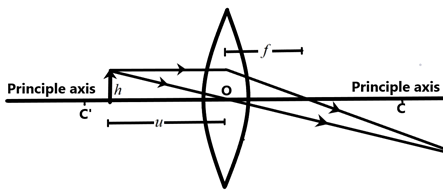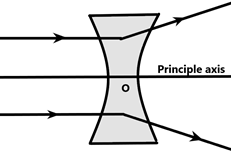
Define the principle axis of a lens.
Answer
561k+ views
Hint: We need to analyse and understand the different physical parameters and the imaginary concepts taken into consideration for the identification of the relation between the image formed by a lens due to an object kept at a point from the lens.
Complete answer:
The lenses are transparent materials which are made of materials such as glass or forms of plastics. These are meant to have a higher refractive index as compared to air as a result of which the light falling on them gets refracted according to the Snell’s law. The refraction of the light rays which come from a point lead to the same point to be formed somewhere away from the lens such that the size of the object and image formed as a result of refraction can vary.
The principle axis in a lens is an imaginary line that passes perpendicular to the length of the lens through the optic center. It is the reference line which passes through the center of curvatures on both sides and the geometric center of a spherical lens. All the light rays falling on the lens are compared to this optical axis for ease of geometry.


The light rays coming parallel to the principle axis are meant to form a point image at the focal point of the lens, whereas, a group of slanting light rays form an image on the focal plane.
This is the required solution.
Note:
The principle axes are drawn for all types of mirrors and lenses including the plane mirror and plane lens. For a plane mirror, all the normal will be parallel to the principle axis. For spherical cases, the normal to the light falling on the optic center will be the principle axis itself.
Complete answer:
The lenses are transparent materials which are made of materials such as glass or forms of plastics. These are meant to have a higher refractive index as compared to air as a result of which the light falling on them gets refracted according to the Snell’s law. The refraction of the light rays which come from a point lead to the same point to be formed somewhere away from the lens such that the size of the object and image formed as a result of refraction can vary.
The principle axis in a lens is an imaginary line that passes perpendicular to the length of the lens through the optic center. It is the reference line which passes through the center of curvatures on both sides and the geometric center of a spherical lens. All the light rays falling on the lens are compared to this optical axis for ease of geometry.


The light rays coming parallel to the principle axis are meant to form a point image at the focal point of the lens, whereas, a group of slanting light rays form an image on the focal plane.
This is the required solution.
Note:
The principle axes are drawn for all types of mirrors and lenses including the plane mirror and plane lens. For a plane mirror, all the normal will be parallel to the principle axis. For spherical cases, the normal to the light falling on the optic center will be the principle axis itself.
Recently Updated Pages
The number of solutions in x in 02pi for which sqrt class 12 maths CBSE

Write any two methods of preparation of phenol Give class 12 chemistry CBSE

Differentiate between action potential and resting class 12 biology CBSE

Two plane mirrors arranged at right angles to each class 12 physics CBSE

Which of the following molecules is are chiral A I class 12 chemistry CBSE

Name different types of neurons and give one function class 12 biology CBSE

Trending doubts
Sketch the electric field lines in case of an electric class 12 physics CBSE

Explain the formation of energy bands in solids On class 12 physics CBSE

Mention any two factors on which the capacitance of class 12 physics CBSE

Drive an expression for the electric field due to an class 12 physics CBSE

Draw a ray diagram of compound microscope when the class 12 physics CBSE

a Draw Labelled diagram of Standard Hydrogen Electrode class 12 chemistry CBSE




